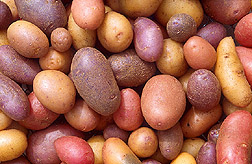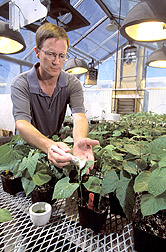This page has been archived and is being provided for reference purposes only. The page is no longer being updated, and therefore, links on the page may be invalid.
| October 2010 |
Luteolin Stars in Study of Healthful Plant CompoundsPrecise details of how six natural compounds in plants—luteolin, quercetin, chrysin, eriodicytol, hesperetin, and naringenin—apparently act as anti-inflammatory agents in the human body are being teased out in studies led by Agricultural Research Service (ARS) scientists. Luteolin is found in celery, thyme, green peppers and chamomile tea. Foods rich in quercetin include capers, apples, and onions. Chrysin is from the fruit of blue passionflower, a tropical vine. Oranges, grapefruit, lemons, and other citrus fruits are good sources of eriodicytol, hesperetin and naringenin. The ARS scientists showed, for the first time, that all six plant compounds target an enzyme known as TBK1. Each compound inhibits, to a greater or lesser extent, TBK1's ability to activate a specific biochemical signal. If unimpeded, the signal would lead to formation of gene products known to trigger inflammation in the body. For details, contact: Daniel Hwang, (530) 754-4838, Immunity and Disease Prevention Research Unit, ARS Western Human Nutrition Research Center, Davis, Calif. |
|
Genetic Screening Technique Can Detect More Than 700 Antimicrobial-Resistance GenesUsing an advanced genetic screening technique, Agricultural Research Service (ARS) scientists and cooperators have detected, for the first time, more than 700 genes that give microbes like Salmonella and E. coli the ability to resist antibiotics and other antimicrobial compounds. The researchers used what is called DNA microarray technology to find the resistance genes in a wide variety of bacteria such as Salmonella, E. coli, Campylobacter, Listeria, and Enterococcus, among others. These organisms can cause food poisoning and are thus a major public health concern. Researchers are concerned that some of these organisms have acquired genetic resistance to the antibiotics used to kill them. Finding the genes that confer resistance is an important step for scientists looking for new ways to control these organisms. The ARS scientists selected about 1,000 unique genes from among 5,000 genes found in GenBank that included the words "antimicrobial resistance" in their description. Then they designed a microarray of more than 700 DNA probes to detect the resistance genes. For details, contact: Jonathan Frye, (706) 546-3677, Bacterial Epidemiology and Antimicrobial Resistance Research Unit, ARS Richard B. Russell Agricultural Research Center, Athens, Ga. |
|
|
|
New Methods Developed to Detect and Measure Potato PhytonutrientsNew analytical procedures for rapidly detecting and measuring phytonutrient concentrations in potatoes have recently been devised by Agricultural Research Service (ARS) researchers and their colleagues. Using the new analytic methods, the researchers profiled the phytonutrient contents of several hundred lines of wild and cultivated potato. For example, their analysis of phytonutrients known as phenolics showed concentrations that ranged from 100 to more than 1,500 milligrams per 100 grams dry weight in the potatoes. For details, contact: Roy Navarre, (509) 786-9261, ARS Vegetable and Forage Crop Research Unit, Prosser, Wash. |
Model Predicts Individual's Vitamin D NeedsAgricultural Research Service (ARS) scientists and their colleagues have developed a preliminary model that predicts an individual's vitamin D requirements. To develop the preliminary model, the scientists worked with 72 young adult volunteers who provided intermittent records of what they ate and, for 7- to 8-week stints, wore photosensitive badges from 7 a.m. to 7 p.m. so the scientists could determine their level of sun exposure. Data from the volunteers—either African-American or of European ancestry—who had relatively low amounts of sun exposure suggest that they may need additional vitamin D to reach a target blood level of 75 nanomoles of vitamin D per liter of plasma. However, the scientists cautioned that some vitamin D levels indicated by the model exceed the level currently considered safe. More research, with a larger number of volunteers, may refine the predictive power of the model. For details, contact: Charles B. Stephensen, (530) 754-9266, Immunity and Disease Prevention Research Unit, ARS Western Human Nutrition Research Center, Davis, Calif. |
|
ARS Scientists and Their Cooperators Find Genes Involved in Yellow Perch Growth
For details, contact: Brian Shepherd, (414) 382-1767, ARS Dairy Forage and Aquaculture Research Unit, Madison, Wis. |
|
|
|
Bright New Dry Bean for Salads and Other Foods"Crimson," a new cranberry dry bean cultivar, is now available for production in the form of foundation seed that could give rise to a new bumper crop of the colorful legume for 2010. "Crimson" was developed by Agricultural Research Service (ARS) scientists from a cross between the commercial cultivar "Cardinal" and the dry bean breeding line PS98-302-5-5. The combination of the two "parents" has endowed "Crimson" with viral disease resistance and a high yield of shapely, maroon-speckled seed. The seeds of "Crimson" are also beautiful on the inside: The new variety lacks a common but commercially unacceptable blemish called "black heart." For details, contact: Phillip N. Miklas, (509) 786-9258, ARS Vegetable and Forage Crop Research Unit, Prosser, Wash. |











